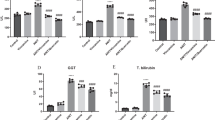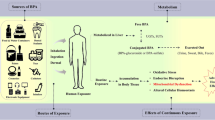Abstract
Chronic nicotine exposure (via smoking, E-cigarettes) increases oxidative stress in the kidney that sensitizes it to additional injury in experimental models and in the renal patient. The pro-apoptotic p66shc protein—via serine36 phosphorylation that facilitates its mitochondrial translocation and therein cytochrome c binding—generates oxidative stress that leads to injury of renal proximal tubule cells during chronic nicotine exposure. Coenzyme Q10—a clinically safe antioxidant—has been used against nicotine/smoke extract-associated oxidative stress in various non-renal cells. This study explored the anti-oxidant/anti-apoptotic effect of Coenzyme Q10 on nicotine-induced oxidative stress and its impact on p66shc in cultured rat renal proximal tubule cells (NRK52E). We studied the anti-oxidant effect of 10 µM Coenzyme Q10 using various mutants of the p66shc gene and also determined the induction of selected anti-oxidant entities (antioxidant response element, promoter of the manganese superoxide dismutase gene) in reporter luciferase assay during oxidative stress induced by 200 µM nicotine. Our studies revealed that Coenzyme Q10 strongly inhibits nicotine-mediated production of reactive oxygen species and consequent apoptosis that requires serine36 phosphorylation but not mitochondrial translocation/cytochrome c binding of p66shc. While both nicotine and Coenzyme Q10 stimulates the p66shc promoter, only nicotine exposure results in mitochondrial translocation of p66shc. In contrast, the Coenzyme Q10-stimulated and non-mitochondrial p66shc activates the anti-oxidant manganese superoxide dismutase promoter via the antioxidant response elements and hence, rescues cells from nicotine-induced oxidative stress and consequent apoptosis.





Similar content being viewed by others
Abbreviations
- ARE:
-
Antioxidant response element
- CHAPS:
-
3-((3-Cholamidopropyl) dimethylammonio)-1-propanesulfonate
- CKD:
-
Chronic kidney disease
- CoQ10:
-
Coenzyme Q10
- DCFDA:
-
2′,7′-Dichlorofluorescein-diacetate
- HBSS:
-
Hank’s balanced salt solution
- MnSOD:
-
Manganese superoxide dismutase
- NIC:
-
Nicotine
- Nrf2:
-
NF-E2 DNA binding protein
- p66shc :
-
Src homology2α/collagen homology protein isoform protein
- ROS:
-
Reactive oxygen species
- siNrf2:
-
Short interfering RNA for Nrf2
- shMnSOD:
-
Short-hairpin MnSOD
- shp66shc:
-
Short-hairpin-p66shc plasmid
References
Baggio B (2000) Ischemic renal disease: impact of cardiovascular risk factors and smoking. Contrib Nephrol 130:68–74
Gambaro G, Verlato F, Budakovic A et al (1998) Renal impairment in chronic cigarette smokers. J Am Soc Nephrol 9:562–567
Orth SR, Hallan SI (2008) Smoking: a risk factor for progression of chronic kidney disease and for cardiovascular morbidity and mortality in renal patients–absence of evidence or evidence of absence? Clin J Am Soc Nephrol 3:226–236
Arany I, Grifoni S, Clark JS, Csongradi E, Maric C, Juncos LA (2011) Chronic nicotine exposure exacerbates acute renal ischemic injury. Am J Physiol Renal Physiol 301:F125–133
EL-S IA, Afifi AM, Shouman AE, EL-S AK (2004) Effects of smoking and lead exposure on proximal tubular integrity among Egyptian industrial workers. Arch Med Res 35:59–65
Hultberg B, Isaksson A, Brattstrom L, Israelsson B (1992) Elevated urinary excretion of beta-hexosaminidase in smokers. Eur J Clin Chem Clin Biochem 30:131–133
Cigremis Y, Turkoz Y, Akgoz M, Sozmen M (2004) The effects of chronic exposure to ethanol and cigarette smoke on the level of reduced glutathione and malondialdehyde in rat kidney. Urol Res 32:213–218
Cigremis Y, Turkoz Y, Tuzcu M et al (2006) The effects of chronic exposure to ethanol and cigarette smoke on the formation of peroxynitrite, level of nitric oxide, xanthine oxidase and myeloperoxidase activities in rat kidney. Mol Cell Biochem 291:127–138
Cobanoglu B, Ozercan IH, Ozercan MR, Yalcin O (2007) The effect of inhaling thinner and/or cigarette smoke on rat kidneys. Inhal Toxicol 19:303–308
Czekaj P, Palasz A, Lebda-Wyborny T et al (2002) Morphological changes in lungs, placenta, liver and kidneys of pregnant rats exposed to cigarette smoke. Int Arch Occup Environ Health 75:S27–35
Hukkanen J, Jacob P III, Benowitz NL (2005) Metabolism and disposition kinetics of nicotine. Pharmacol Rev 57:79–115
Kim KY, Lee YJ, Chung BC, Hong J, Jung BH (2010) Relations between toxicity and altered tissue distribution and urinary excretion of nicotine, cotinine, and hydroxycotinine after chronic oral administration of nicotine in rats. Drug Chem Toxicol 33:166–172
Zeidler R, Albermann K, Lang S (2007) Nicotine and apoptosis. Apoptosis 12:1927–1943
Kim CS, Choi JS, Joo SY et al (2016) Nicotine-induced apoptosis in human renal proximal tubular epithelial cells. PLoS One 11:e0152591
Giorgio M, Migliaccio E, Orsini F et al (2005) Electron transfer between cytochrome c and p66Shc generates reactive oxygen species that trigger mitochondrial apoptosis. Cell 122:221–233
Pellegrini M, Pacini S, Baldari CT (2005) p66SHC: the apoptotic side of Shc proteins. Apoptosis 10:13–18
Arany I, Clark J, Reed DK, Juncos LA (2013) Chronic nicotine exposure augments renal oxidative stress and injury through transcriptional activation of p66shc. Nephrol Dialysis Transplant 28:1417–1425
Zhang ZW, Xu XC, Liu T, Yuan S (2016) Mitochondrion-permeable antioxidants to treat ROS-burst-mediated acute diseases. Ox Med Cell Long 2016:6859523
Fatima S, Al-Mohaimeed N, Al-Shaikh Y et al (2016) Combined treatment of epigallocatechin gallate and Coenzyme Q10 attenuates cisplatin-induced nephrotoxicity via suppression of oxidative/nitrosative stress, inflammation and cellular damage. Food Chem Toxicol 94:213–220
Conklin KA (2005) Coenzyme q10 for prevention of anthracycline-induced cardiotoxicity. Integ Cancer Ther 4:110–130
Bruin JE, Woynillowicz AK, Hettinga BP et al (2012) Maternal antioxidants prevent beta-cell apoptosis and promote formation of dual hormone-expressing endocrine cells in male offspring following fetal and neonatal nicotine exposure. J Diabetes 4:297–306
Kaisar MA, Prasad S, Cucullo L (2015) Protecting the BBB endothelium against cigarette smoke-induced oxidative stress using popular antioxidants: are they really beneficial? Brain Res 1627:90–100
Figuero E, Soory M, Cerero R, Bascones A (2006) Oxidant/antioxidant interactions of nicotine, Coenzyme Q10, Pycnogenol and phytoestrogens in oral periosteal fibroblasts and MG63 osteoblasts. Steroids 71:1062–1072
Arany I, Faisal A, Clark JS, Vera T, Baliga R, Nagamine Y (2010) p66SHC-mediated mitochondrial dysfunction in renal proximal tubule cells during oxidative injury. Am J Physiol Renal Physiol 298:F1214–F1221
Arany I, Megyesi JK, Kaneto H, Price PM, Safirstein RL (2004) Cisplatin-induced cell death is EGFR/src/ERK signaling dependent in mouse proximal tubule cells. Am J Physiol Renal Physiol 287:F543–549
Arany I, Faisal A, Nagamine Y, Safirstein RL (2008) p66shc inhibits pro-survival epidermal growth factor receptor/ERK signaling during severe oxidative stress in mouse renal proximal tubule cells. J Biol Chem 283:6110–6117
Arany I, Hall S, Reed DK, Dixit M (2016) The pro-oxidant gene p66shc increases nicotine exposure-induced lipotoxic oxidative stress in renal proximal tubule cells. Mol Med Rep 14:2771–2777
Kim CS, Jung SB, Naqvi A et al (2008) p53 impairs endothelium-dependent vasomotor function through transcriptional upregulation of p66shc. Circ Res 103:1441–1450
Essers MA, Weijzen S, de Vries-Smits AM et al (2004) FOXO transcription factor activation by oxidative stress mediated by the small GTPase Ral and JNK. Embo J 23:4802–4812
Kannan K, Jain SK (2000) Oxidative stress and apoptosis. Pathophysiology 7:153–163
Tian N, Rose RA, Jordan S, Dwyer TM, Hughson MD, Manning RD Jr (2006) N-Acetylcysteine improves renal dysfunction, ameliorates kidney damage and decreases blood pressure in salt-sensitive hypertension. J Hypertens 24:2263–2270
Arany I, Faisal A, Clark JS, Vera T, Baliga R, Nagamine Y (2010) p66SHC-mediated mitochondrial dysfunction in renal proximal tubule cells during oxidative injury. Am J Physiol Renal Physiol 298:F1214–1221
Nguyen T, Nioi P, Pickett CB (2009) The Nrf2-antioxidant response element signaling pathway and its activation by oxidative stress. J Biol Chem 284:13291–13295
Huang XS, Chen HP, Yu HH, Yan YF, Liao ZP, Huang QR (2014) Nrf2-dependent upregulation of antioxidative enzymes: a novel pathway for hypoxic preconditioning-mediated delayed cardioprotection. Mol Cell Biochem 385:33–41
Ojeda N, Hall S, Lasley CJ, Rudsenske B, Dixit M, Arany I (2016) Prenatal nicotine exposure augments renal oxidative stress in embryos of pregnant rats with reduced uterine perfusion pressure. In vivo (Athens, Greece) 30:219–224
Orth SR, Viedt C, Ritz E (2001) Adverse effects of smoking in the renal patient. Tohoku J Exp Med 194:1–15
Sener G, Sehirli AO, Ipci Y, Cetinel S, Cikler E, Gedik N (2005) Chronic nicotine toxicity is prevented by aqueous garlic extract. Plant Foods Hum Nutr 60:77–86
Sener G, Sehirli O, Ipci Y et al (2005) Protective effects of taurine against nicotine-induced oxidative damage of rat urinary bladder and kidney. Pharmacology 74:37–44
Bruin JE, Petre MA, Lehman MA et al (2008) Maternal nicotine exposure increases oxidative stress in the offspring. Free Radic Biol Med 44:1919–1925
Cormier A, Morin C, Zini R, Tillement JP, Lagrue G (2001) In vitro effects of nicotine on mitochondrial respiration and superoxide anion generation. Brain Res 900:72–79
Galimov ER. (2010) The role of p66shc in oxidative stress and apoptosis. Acta Naturae 2:44–51
Gertz M, Steegborn C (2010) The Lifespan-regulator p66Shc in mitochondria: redox enzyme or redox sensor? Antioxid Redox Signal 13:1417–1428
Pellegrini M, Baldari CT (2009) Apoptosis and oxidative stress-related diseases: the p66Shc connection. Curr Mol Med 9:392–398
Garrido-Maraver J, Cordero MD, Oropesa-Avila M et al (2014) Clinical applications of coenzyme Q10. Front Biosci 19:619–633
Abitagaoglu S, Akinci SB, Saricaoglu F et al (2015) Effect of coenzyme Q10 on organ damage in sepsis. Bratisl Lek Listy 116:433–439
Maheshwari RA, Balaraman R, Sen AK, Seth AK (2014) Effect of coenzyme Q10 alone and its combination with metformin on streptozotocin-nicotinamide-induced diabetic nephropathy in rats. Ind J Pharmacol 46:627–632
Fatima S, Al-Mohaimeed N, Arjumand S, Banu N, Al-Jameil N, Al-Shaikh Y (2015) Effect of pre- and post-combined multidoses of epigallocatechin gallate and coenzyme Q10 on cisplatin-induced oxidative stress in rat kidney. J Biochem Mol Toxicol 29:91–97
Li L, Du J, Lian Y et al (2016) Protective effects of Coenzyme Q10 against hydrogen peroxide-induced oxidative stress in PC12 Cell: the role of Nrf2 and antioxidant enzymes. Cell Mol Neurobiol 36:103–111
Choi HK, Pokharel YR, Lim SC et al (2009) Inhibition of liver fibrosis by solubilized coenzyme Q10: role of Nrf2 activation in inhibiting transforming growth factor-beta1 expression. Toxicol Appl Pharmacol 240:377–384
Wakabayashi N, Slocum SL, Skoko JJ, Shin S, Kensler TW (2010) When NRF2 talks, who’s listening? Antioxid Redox Signal 13:1649–1663
Orsini F, Migliaccio E, Moroni M et al (2004) The life span determinant p66Shc localizes to mitochondria where it associates with mitochondrial heat shock protein 70 and regulates trans-membrane potential. J Biol Chem 279:25689–25695
Miyazawa M, Tsuji Y (2014) Evidence for a novel antioxidant function and isoform-specific regulation of the human p66Shc gene. Mol Biol Cell 25:2116–2127
Ventura A, Luzi L, Pacini S, Baldari CT, Pelicci PG (2002) The p66Shc longevity gene is silenced through epigenetic modifications of an alternative promoter. J Biol Chem 277:22370–22376
Premkumar VG, Yuvaraj S, Shanthi P, Sachdanandam P (2008) Co-enzyme Q10, riboflavin and niacin supplementation on alteration of DNA repair enzyme and DNA methylation in breast cancer patients undergoing tamoxifen therapy. Brit J Nutr 100:1179–1182
Pinton P, Rimessi A, Marchi S et al (2007) Protein kinase C beta and prolyl isomerase 1 regulate mitochondrial effects of the life-span determinant p66Shc. Science 315:659–663
Mai Y, Higashi T, Terada K et al (2012) Nicotine- and tar-free cigarette smoke extract induces cell injury via intracellular Ca2+-dependent subtype-specific protein kinase C activation. J Pharmacol Sci 120:310–314
Cho YA, Jue SS, Bae WJ et al (2015) PIN1 inhibition suppresses osteoclast differentiation and inflammatory responses. J Dent Res 94:371–380
Tsuneki H, Sekizaki N, Suzuki T et al (2007) Coenzyme Q10 prevents high glucose-induced oxidative stress in human umbilical vein endothelial cells. Eur J Pharmacol 566:1–10
Acknowledgments
This work was supported by the Department of Pediatrics, University of Mississippi Medical Center and the Bower Foundation. The Authors wish to thank Dr. Irani for the p66shc-promoter luciferase plasmid and to Dr. Burgering for the MnSOD-promoter luciferase plasmid.
Author information
Authors and Affiliations
Corresponding author
Rights and permissions
About this article
Cite this article
Arany, I., Carter, A., Hall, S. et al. Coenzyme Q10 protects renal proximal tubule cells against nicotine-induced apoptosis through induction of p66shc-dependent antioxidant responses. Apoptosis 22, 220–228 (2017). https://doi.org/10.1007/s10495-016-1309-3
Published:
Issue Date:
DOI: https://doi.org/10.1007/s10495-016-1309-3




